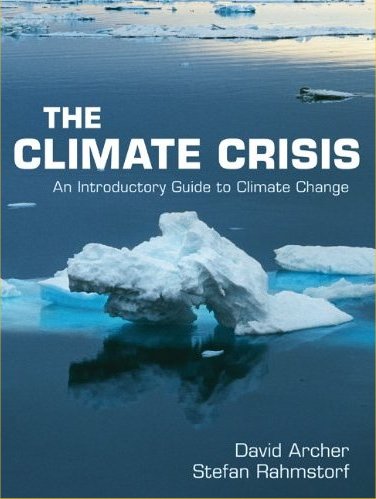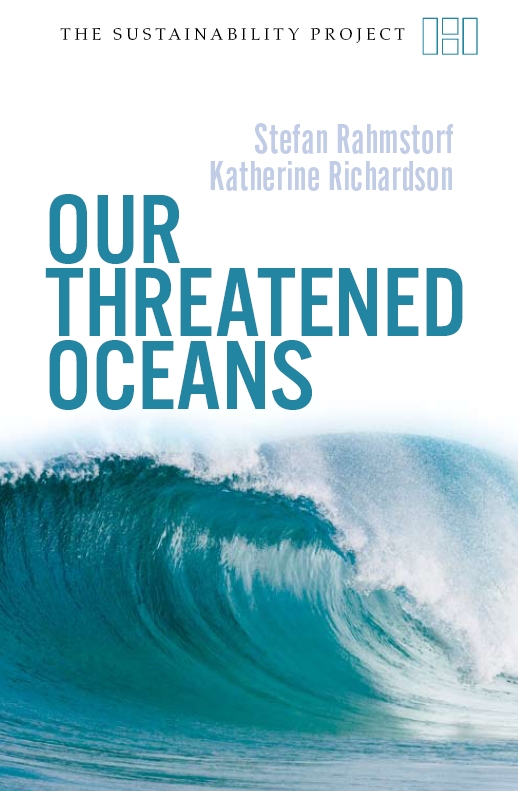Anthropogenic climate change: the risk of unpleasant surprises
By Stefan Rahmstorf, Potsdam Institute for Climate Impact ResearchPublished 2000 in: Flexible mechanisms for an efficient climate policy, edited by K. L. Brockmann and M. Stronzik, Physica-Verlag, Heidelberg, pp. 7-11.
During the past few years, our understanding of the global climate has gone through a silent revolution. Our old image was based on slow climatic cycles, in which over many millennia ice ages came and passed, driven by the slow cyclical changes of the Earth's orbit around the sun.
This concept was, above all, derived by retrieving cores from the muddy sediment layers at the bottom of the oceans, which were deposited over the course of many millions of years and form a unique climatic archive. Since in most places only a few centimetres of sediment are deposited over a thousand years, these cores revealed at first only the slow climatic cycles. It was possible, for example, to make out that the last ice age started about 120,000 years ago and ended 10,000 years ago. During this glacial period our ancestors had to survive by hunting mammoths in the icy steppes. The stable period of warmth which followed (and which prevails until today), the Holocene, was the prerequisite for the development of agriculture and modern human civilisation.
Climatic jumps and jolts
A completely new picture of climatic history was gained mainly from ice cores drilled from the Greenland ice cap, which allow a much higher resolution in time1. In these ice cores it is even possible to distinguish the individual annual layers of winter snowfall, similar to the annual rings of trees. In addition to the slow cycles already known, abrupt climatic changes could now be identified, during which climatic conditions changed dramatically within a few years. At the end of the last glacial period, when the planet was generally warming up, a sudden lapse into an extreme period of cold occurred in the Northern Hemisphere, the so-called Younger Dryas event, which lasted for almost one thousand years. During the last ice age, altogether 24 such abrupt cooling events are recorded. Clearly the climatic system has the tendency to make sudden jolts.
The causes of rapid climate shifts have not been fully
understood so far. However, everything points to the fact that they are
not caused by sudden changes in external factors like solar radiation,
but lie in the changeable nature of the climate system itself. In other
words, climate is a strongly non-linear system. Linear systems are very
simple: if they are forced, they react more strongly the greater the forcing,
or stimulus, is. The connection between stimulus and reaction is a straight
line - it is "linear". Complex systems are almost always strongly non-linear.
These are characterised by a tendency towards self-regulation and sudden
transition to a qualitatively different state when a certain critical threshold
is exceeded.
Swimmers in the Sahara
The climate system appears to have the ability to self-regulation, within certain limits. An interesting example of this is the Sahara. Alexander von Humboldt already concluded after his trip to the Amazon that the rainforest helps to generate clouds and rain, and that enough rain might fall in the Sahara for abundant growth if only there were trees. Using computer simulations, my colleagues at the Potsdam Institute have shown that a green Sahara would indeed have the tendency to attract humid air from the Atlantic and monsoon rain2. In fact, at the beginning of the Holocene, the Sahara was green. Evidence of this is not only obtained from rock art like in the famous "Cave of Swimmers" in the Gilf Kebir (a lake was just outside the cave at the time of the creation of the murals), but also from archaeological findings such as hippopotamus bones. Due to the slow change in the orbit of the Earth around the sun, the conditions for monsoon rain in the Sahara deteriorated over the millennia. But apparently the vegetation did not slowly and gradually decline in step with the orbital change - i.e., in a linear way - but instead was able to sustain itself almost completely up to a certain point in time, after which it suddenly died from drought conditions. Within a relatively short period of time, the Sahara changed into the dry desert it has remained until today. Both data and computer simulations show this sequence of events. The population of the Sahara, which had been scattered over wide stretches of land, had to flee and was crammed together in the Nile valley - a factor which may have contributed to the emergence of the sophisticated culture of the Pharaones.
Will the Gulf Stream cease to exist?
Another example of non-linearity in the climate system, which is now rather well-understood, is the Atlantic ocean circulation3, 4. Extending along the entire Atlantic, from the Cape of Good Hope in the South up to Svalbard in the North, a gigantic overturning motion of water takes place, in which the surface waters flow northward, sink down and return south at a depth of two to three thousand metres. The Gulf Stream off the North-American coast and its extension to Europe, the North Atlantic Current, are elements in this larger circulation system, which is driven by differences in the density of the seawater. Where the highest densities are reached, in the Greenland sea and in the Labrador sea, the water sinks down, drawing further water northward like the plug-hole of a bath. The amount of water turned over in this way equals twenty times the flow of all rivers of the Earth combined. As the northward-flowing surface water is considerably warmer than the deep water returning south (which after all comes from the arctic), this system functions like central heating for Europe. Huge amounts of heat, corresponding to the output of half a million large power plants, are transported to the North Atlantic. There the heat is transferred to the air and then carried to Europe by westerly winds. This is why it is cold in winter in Europe if the wind comes from the East, but mild if the wind comes from the West. Looking at climate maps one notices that in Northern Germany the climate is roughly five degrees too warm for the latitude - the respective latitudes of Canada are considerably colder, even on the Pacific Coast. In contrast to the Atlantic, the Pacific has no built-in central heating.
Unfortunately, the Atlantic ocean circulation has a drawback: it is not entirely stable. During the past ten thousand years, our heating system has worked without problems, albeit with some minor variations. But in the more distant past, it has stuttered badly and, during the extreme cold events in the glacial period mentioned above, it even repeatedly collapsed completely. This is revealed by the deep sea sediments5.
The reason for the strange behaviour of the currents has been analysed with the help of computer simulations and can be easily understood. In order to be heavy enough to sink down, the water of the North Atlantic has to contain enough salt, as salt increases the density of the water. An opposing effect is precipitation, which lowers the density of the water. However, this effect is offset as long as new, salty water continues to flow in from the South. In short, the current flows because the water is salty, and the water is salty because the current is flowing. This is a clear case of a self-sustaining system. If in the computer simulation the precipitation over the North Atlantic is further increased, the current is, at first, only moderately weakened. But at some stage a point is reached when the influx of new salty water becomes too weak. The precipitation dilutes the water, the current becomes even weaker - a vicious circle which eventually leads to the complete breakdown of the current. Here we have a classic example of a non-linear system which regulates itself within certain limits, but which then all of a sudden experiences a dramatic change if these limits are exceeded.
This finding is of concern since due to the anthropogenic greenhouse effect, precipitation in the North Atlantic region is expected to increase. In his article "Unpleasant Surprises in the Greenhouse"6, the American climatologist Wallace Broecker warned in 1987 that due to the greenhouse effect, man might cause the Atlantic circulation to stop. Since then, several groups of researchers have been working on a closer examination of the stability of this current.
Present knowledge gives no reason for panic, but also
no reason for "all clear". It is likely that during the next decades
the North Atlantic Current will weaken noticeably - simulations of the
various institutes agree on this point. Although this will gradually wind
down Europe's central heating, it will not lead to dropping temperatures
- for at the same time, over the whole planet, temperatures are rising
due to the greenhouse effect, and this effect also prevails in Europe.
Risky Greenhouse
What will happen in the longer term is far less certain. If man continues to enrich the atmosphere of our planet with greenhouse gases such as carbon dioxide, the global climate could get close to the point where the North Atlantic current is interrupted. Due to the inaccuracy of present climate models, it is not possible to date to make a clear statement as to where exactly this point lies and whether and when it might be exceeded.
It is another characteristic of non-linear systems that the prediction of future trends is considerably more difficult than with linear systems. The existence of critical thresholds which, if exceeded, would mean a sudden qualitative change of climate is in principle easily understood. But where exactly these points lie, and the behaviour of the climate system near such points, is difficult to calculate. The new findings mean, above all, more uncertainty. The more we drive climate away from its present equilibrium, the higher the risk of unpleasant surprises becomes. Broecker once put it like this: Climate is an unpredictable wild beast, and we are poking at it with sticks.
What could an interruption of the North-Atlantic current look like? At the Potsdam Institute we have calculated several scenarios7 and found that temperatures in Europe would at first rise significantly, although perhaps slightly less than the global mean temperature - in our scenario by about three degrees until the year 2100. This warming could be followed by an ocean circulation collapse and a sudden drop in temperature back to the pre-industrial level. Over the following centuries, when the carbon dioxide content of the atmosphere will slowly drop again (as mankind is unlikely to infinitely use fossil fuels to the extent we are using them now), temperatures in Europe will fall further and further, until they will finally be about five degrees colder than at present. A roller coaster ride for us Europeans, which would require constant adjustments, first to a warmer and then to a colder climate. At the end the climate would be so cold and dry that agriculture would be hardly possible.
The climatic state that would then be reached - an Earth without the "central heating system" provided by the North Atlantic current - would, according to our calculations, be stable over future millennia. This means that mankind could, by a temporary perturbation of the climate lasting only a few centuries, shift the planet into a completely different climatic state due to its excessive use of fossil fuels.
Whether we should risk such a far-reaching and dangerous
interference with the climate system is a political and ethical question.
From the purely factual viewpoint of a climatologist, who examines the
fluctuations of global climate over millions of years, there is of course
no climatic state that is 'better' than another one, and constant change
is the rule. There is however no doubt that extensive and rapid climatic
change bears substantial dangers for mankind. Our eco-systems, agriculture,
and settlement structures are based on current climatic conditions, and
every large change can lead to great misery. In decades to come, man will
become the dominant cause of climate change. The recognition that the climate
has a tendency towards sudden jolts should make us cautious.
References
1. Blunier, T., et al. Asynchrony of Antarctic and Greenland climate change during the last glacial period. Nature 394, 739-743 (1998).
2. Ganopolski, A., Kubatzki, C., Claussen, M., Brovkin, V. & Petoukhov, V. The role of vegetation-atmosphere-ocean interaction for the climate system during the mid-Holocene. Science280, 1916-1919 (1998).
3. Rahmstorf, S. Risk of sea-change in the Atlantic. Nature 388, 825-826 (1997).
4. Rahmstorf, S. Shifting seas in the greenhouse? Nature 399, 523-524 (1999).
5. Bond, G., et al. Correlations between climate records from North Atlantic sediments and Greenland ice. Nature 365, 143-147 (1993).
6. Broecker, W. Unpleasant surprises in the greenhouse? Nature 328, 123 (1987).
7. Rahmstorf, S. & Ganopolski, A. Long-term global
warming scenarios computed with an efficient coupled climate model. Clim.
Change , in press (1999).













